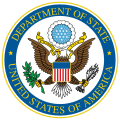
A diplomatic mission or foreign mission is a group of people from a state or organization present in another state to represent the sending state or organization officially in the receiving or host state. In practice, the phrase usually denotes an embassy or high commission, which is the main office of a country's diplomatic representatives to another country; it is usually, but not necessarily, based in the receiving state's capital city. Consulates, on the other hand, are smaller diplomatic missions that are normally located in major cities of the receiving state. As well as being a diplomatic mission to the country in which it is situated, an embassy may also be a nonresident permanent mission to one or more other countries.

The Bund is a waterfront area and a protected historical district in central Shanghai. The area centers on a section of Zhongshan Road within the former Shanghai International Settlement, which runs along the western bank of the Huangpu River in the eastern part of Huangpu. The area along the river faces the modern skyscrapers of Lujiazui in Pudong. The Bund usually refers to the buildings and wharves on this section of the road, as well as some adjacent areas. This region has a significant European influence, with the style of many structures most comparable to that of European cities, particularly Gothic, Baroque, Neoclassical, Romanesque, Art Deco, and Renaissance architecture. Additionally, some of the city's top eateries are located there. From the 1860s to the 1930s, it was the rich and powerful center of the foreign establishment in Shanghai, operating as a legally protected treaty port.

The Shanghai International Settlement originated from the merger in the year 1863 of the British and American enclaves in Shanghai, in which British and American citizens would enjoy extraterritoriality and consular jurisdiction under the terms of unequal treaties agreed by both parties. These treaties were abrogated in 1943.
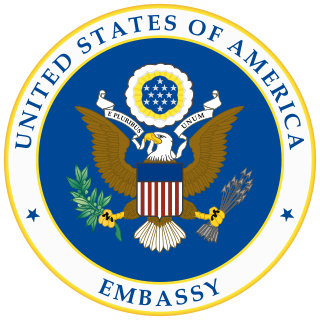
The Embassy of the United States of America in Tokyo represents the United States in Tokyo, Japan. Along with consulates in Osaka, Nagoya, Sapporo, Fukuoka, and Naha, the Embassy provides assistance to American citizens and residents who live in Japan and issues visas to Japanese nationals, and legal residents in Japan who wish to visit or immigrate to the United States.
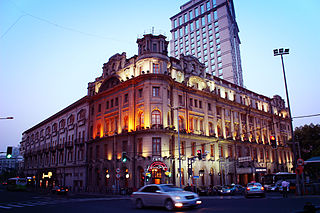
The Astor House Hotel, known as the Pujiang Hotel (浦江饭店) in Chinese from 1959-2018, was described as once "one of the famous hotels of the world". Established in 1846 as Richards' Hotel and Restaurant (礼查饭店) on The Bund in Shanghai, it was located at 15 Huangpu Lu, Shanghai, near the confluence of the Huangpu River and the Suzhou Creek in the Hongkou District, near the northern end of the Waibaidu (Garden) Bridge, from 1858 on. The hotel closed on 1 January 2018, after being purchased by an undisclosed local business. It was converted to the China Securities Museum, which opened in December 2018.

A consul is an official representative of a government who resides in a foreign country to assist and protect citizens of the consul's country, and to promote and facilitate commercial and diplomatic relations between the two countries.

A consulate is the office of a consul. A type of diplomatic mission, it is usually subordinate to the state's main representation in the capital of that foreign country, usually an embassy. The term "consulate" may refer not only to the office of a consul, but also to the building occupied by the consul and the consul's staff. The consulate may share premises with the embassy itself.

The United States Court for China was a United States district court that had extraterritorial jurisdiction over U.S. citizens in China. It existed from 1906 to 1943 and had jurisdiction in civil and criminal matters, with appeals taken to the U.S. Court of Appeals for the Ninth Circuit in San Francisco.
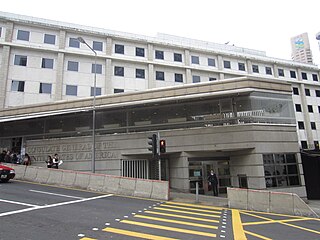
The Consulate General of the United States, Hong Kong and Macau, represents the United States in Hong Kong and Macau.
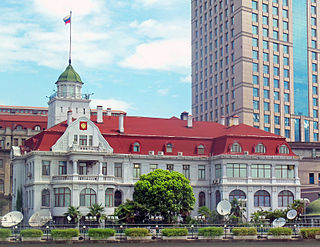
The Consulate-General of the Russian Federation in Shanghai is the diplomatic mission of Russia in Hongkou District, Shanghai. It is located at 20 Huangpu Road on The Bund in Shanghai, next to the Garden Bridge near the convergence of the Suzhou and Huangpu rivers, and across the road from the Astor House Hotel. It was established in 1896 and has occupied the present building since 1917.
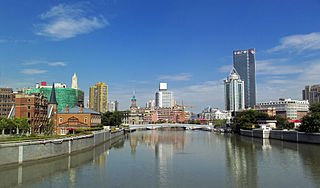
Suzhou Creek, also called the Wusong (Woosung) River, is a river that passes through the Shanghai city center. It is named after the neighboring city of Suzhou (Soochow), Jiangsu, the predominant settlement in this area prior to the rise of Shanghai as a metropolis.

The Shanghai French Concession was a foreign concession in Shanghai, China from 1849 until 1943, which progressively expanded in the late 19th and early 20th centuries. The concession came to an end in 1943, when Vichy France under German pressure signed it over to the pro-Japanese Reorganized National Government of China in Nanjing. For much of the 20th century, the area covered by the former French Concession remained the premier residential and retail district of Shanghai, and was also one of the centers of Catholicism in China. Despite re-development over the last few decades, the area retains a distinct character and is a popular tourist destination.

The Consulate-General of the People's Republic of China in Los Angeles is the People's Republic of China's (PRC) diplomatic mission headquartered at 443 Shatto Place in the Koreatown neighborhood of Los Angeles, California, United States. The passport and visa office is on the third floor of 500 Shatto Place, Los Angeles, California. The consulate's service area is Southern California, Arizona, Hawaii, New Mexico, and the U.S. Pacific territories.

The Former Consulate-General of the United Kingdom (英国驻上海总领事馆) building located in Shanghai, China, is one of the oldest buildings on the Bund.

The British Supreme Court for China was a court established in the Shanghai International Settlement to try cases against British subjects in China, Japan and Korea under the principles of extraterritoriality.

The American Concession or Settlement was a foreign enclave within present-day Shanghai which existed from around 1848 until its unification with the city's British area to form the Shanghai International Settlement in 1863.

The Consulate General of the United States of America in Chennai represents the interests of the United States government in Chennai, India and surrounding regions. The consulate reports to the ambassador at the U.S. Embassy in New Delhi. The current Consul General, the 27th, is Christopher W. Hodges, incumbent since July 2023. He was preceded by Judith Ravin.

The Consulate General of the United States in Wuhan is one of the five American diplomatic and consular posts in mainland of the People's Republic of China.

The Consulate General of the United States, Shenyang is one of seven American diplomatic and consular posts in the People's Republic of China. It is located in Heping District, Shenyang, Liaoning.

The Consulate General of United States, Guangzhou is one of seven American diplomatic and consular posts in China. It is one of America's earliest diplomatic posts in the Far East. The consulate serves the South China region, covering the provinces of Guangdong, Hainan and Fujian, and the Guangxi Zhuang Autonomous Region, an area which, according to the latest census in 2020, has a resident population of over 220 million. The consulate general is also the only U.S. mission in mainland China to process American adoptions and immigrant visas, making it one of the U.S. Department of State’s busiest consular-related posts.
